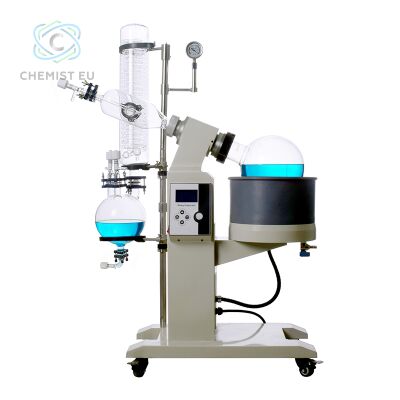What is the limitation of rotary evaporator?
Published on November 23, 2023
Limitation of rotary evaporator
What is a rotary evaporator?
The rotary evaporator is a complex device designed for distillation of liquids at reduced pressure. Due to the vacuum in the system, which is formed by using a water jet or vacuum pump, the vaporization temperature of the distilled material is significantly reduced. This prevents excessive heating of the analyzed sample.
In labs involved in research, pharmaceutical and food production, vacuum rotary evaporators are of enduring importance when substances need to be distilled under strictly controlled conditions.
With the increasing popularity of molecular cuisine, rotary evaporators have been widely used in the preparation of sauces and extracts. This opens up new horizons of gastronomic combinations: fish flavored with strawberries or desserts enveloped in the aromas of favorite flowers.
How Does a Rotary Evaporator Work?
The lab rotary vacuum evaporator structure includes several key components, namely:
- A tank with a water or oil bath – the place where the starting mixture is located.
- Distillation flask and receiving flask – these two are linked by the distillation and condensation process.
- Reverse refrigerator – the element responsible for condensing the vapors of the volatile component.
- Rotating mechanism of the flask – provides uniform heating and vaporization surface.
- Tripod and connecting parts – provide stability and connection of all components.
However, the main functional element of the vacuum rotary vaporizer is the vacuum maintenance system. This device creates and maintains a vacuum environment within the system.
Under the effect of heating, the lighter components of the mixture begin to vaporize even before the liquid reaches boiling point, due to the presence of vacuum. The vaporized molecules fall onto the cooled surface of the reflux condenser, where they condense into a liquid form that collects in the receiving flask. The rotation system of the distillation flask plays an important role, ensuring not only uniform heating but also constant renewal of the vaporization surface.
To facilitate the use of vacuum rotary evaporator, several high-tech options have been developed:
- Automatic elevator for easy removal of the flask from the heating medium.
- Possibility to change the direction of rotation to optimize the process.
- Control of cooling water and vacuum level.
- Built-in timer function for precise process adjustment.
- Programming of individual procedures according to requirements.
- Possibility to use the built-in solvent library for a variety of experiments.
In summary, the Vacuum Rotary Evaporator is a sophisticated system with several key components designed for efficient and convenient laboratory operation.
What is the limitation of rotary evaporator?
A potential for different types of samples, such as ethanol and water, to collide is a key disadvantage of rotary evaporators, in addition to the fact that they are designed for single samples. This can result in the loss of some substance intended to be held.
Rotary evaporator equipment that has a sealed seal is limited in life and requires periodic replacement. As such, users will have to spend more time and money to replace sealed equipment on a regular basis.
Samples may be subject to exposure to air, resulting in contamination of sample materials and extracted components. Contamination of sample substances will certainly affect the purity of extracted materials, resulting in lower quality experiments.
Cleaning the glassware included in the rotary evaporator requires a high frequency, as this type of equipment requires the use of only immaculately clean containers in order to ensure the highest purity of materials. If there are any impurities in the glassware, the extracted substances will not be absolutely pure.



